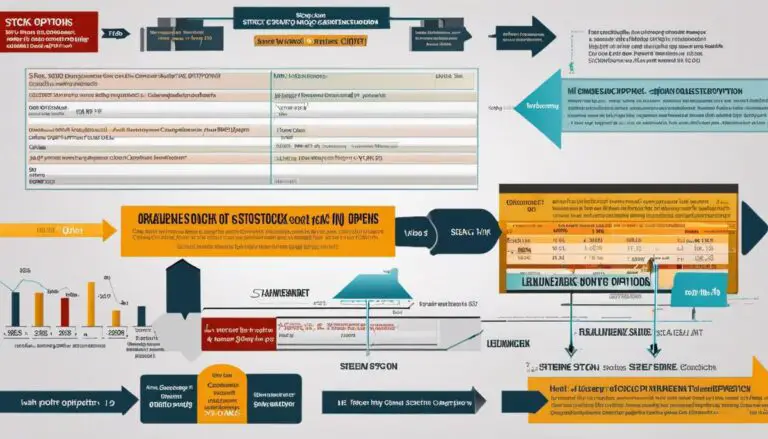In the dynamic world of finance, understanding investment instruments such as stock options becomes crucial. An essential tool used extensively in the market, stock options hold immense potential but at the same time carry unique risks. Developed a clear understanding of the basics of stock options, including their mechanisms like the strike price, type — call and put options — and the underlying asset, is key to unlocking their benefits. It is equally important to recognize the potential pitfalls and advantages associated with stock options, whether it is an advantageous tool for compensation, speculation, hedging against other investments or consequences of being an illiquid investment or susceptible to market volatility.
The Basics of Stock Options
The Key Dynamics & Core Principles of Engaging with Stock Options: A Transformative Entrepreneurial Perspective
From the humble start-ups in your local neighborhood to the colossal technology giants in Silicon Valley, companies invest immense efforts in enticing top-tier talent. They do this not just through competitive salaries, but also through a currency much coveted in today’s modern market: stock options. Stock options, with their intricate rules, volatility, and limitless profit margin, function both as a lucrative incentive and a complex game of numbers. Understanding their dynamics and principles is pivotal to maximize these financial instruments for wealth accumulation.
A stock option is essentially an agreement that offers the holder the right, but not the obligation, to buy a company’s stock at a predefined price; This price is also known as the ‘strike price.’ The real magic arises when the market price of the shares outstrips the strike price, facilitating solid profits. Making sense of this whirlwind of numbers and executing a profitable strategy requires a strong grasp of some fundamental principles.
First and foremost: it’s all about timing. Crafting effective stock options strategies revolves around the dual axis of time and asset price movements. Strike when the iron is hot, as they say. But be warned, timing the market terrain accurately is a challenging feat even for seasoned Wall Street veterans. That said, it forms a vehicle for employees to partake in the growth journey, reaping the fruits of a company’s success.
Secondly, the underlying asset. Stock options refer to stocks. But, that’s not to say that the concepts underpinning options don’t apply to other assets. One could engage with options for a plethora of assets like currencies, commodities, bonds, etc. Diversification serves as a key tactic in mitigating risk and optimizing returns.
Mind the volatility. Stock options carry a high degree of risk, primarily because of lifestyle market fluctuations. The economic environment, corporate performance and global activities feed into this volatility. This makes staying up-to-date with the latest market trends and making informed decisions a critical task in managing stock options.
Moreover, knowledge remains the greatest weapon in the stock options realm. Deciphering the financial jargon, analyzing the convoluted market trends, and understanding tax implications require a sound knowledge base. Continuous learning is a cornerstone to harness the maximum potential from your stock holdings.
While these principles facilitate comprehension of the stock options terrain, they merely scratch the surface. Engaging with stock options isn’t for the faint-hearted. It demands a calculated risk-taking temperament, a solid grasp of finance, and an entrepreneurial spirit that thrives on innovation.
But remember, at the heart of it all, is the simple, yet profound entrepreneurial philosophy we aspire to: Create remarkable value and the wealth will follow. As we navigate the world of stock options, these core principles serve as a guiding light, unveiling the path toward well-deserved wealth and the relentless pursuit of growth.
In the end, it’s not about ‘making a quick buck’. Instead, it’s about aligning individual aspirations with a company’s growth story. It’s about creating long-term wealth; it’s about transforming financial dreams into reality. Stock options are more than just a popular buzzword; they are significant wealth creation tools in this dynamic modern market, if you understand their principles and adapt to their dynamics.

Advantages and Risks of Stock Options
The Strategy of Hedging in Stock Options
One of the key strategies used in managing the risks in stock options is hedging. This involves taking an offsetting position in the market to balance any potential losses. The primary objective of hedging is to minimize or control risk. As a savvy investor, your ability to leverage hedging tactics to your advantage will play a significant role in your journey towards financial success.
Essential to this approach is understanding how the prices of options react to changes in the underlying asset’s price, both of which are time-sensitive in nature. It’s a dynamic but delicate balance. Knowing when to hedge, and by how much, requires a level of expertise only gained through experience and extensive market understanding.
The Risk-Reward Ratio in Stock Options
Inherent in every stock options investment strategy is the risk/reward ratio. This is often calculated as the potential profit that could be made from a trade divided by the amount risked to achieve that profit. This ratio helps investors to set their profitability thresholds while also ensuring they keep potential losses within bearable limits.
This is where the power of calculated risk comes in. Being willing to accept higher risks can equate to potentially higher returns if things swing in your favor. Conversely, playing it safe may offer more stability but can limit the financial upside. Understanding your personal risk tolerance is, therefore, essential in crafting your investment strategy.
The Role of Professional Networking
Leveraging a healthy professional network can act as a significant catalyst in an investor’s stock options journey. This network can provide critical insights and trends that are often missed in single investor scenarios. The power of shared knowledge cannot be underestimated in a field where timely information is gold.
Seeing the Potential in the Market Swings
It’s worth mentioning, volatility isn’t always a bad thing. In fact, volatility can present tremendous opportunities for those savvy enough to seize them. A fluctuating market sometimes exposes new avenues for growth and fresh perspectives for wealth creation.
With options, you can strategize multiple positions in the market simultaneously, each trading on different predictions of the asset’s future movement. By doing so, one can profit from the market in multiple possible scenarios – whether it rises, falls, or even shifts sideways. This is where the unbeatable advantage of stock options lies; in their flexibility to engage the market from various angles.
Remember, trading in stock options is not a quick sprint but a calculated marathon, calling for stratagem, resilience, and an entrepreneurial spirit. It’s about finding the perfect balance between risk and reward, leveraging professional networks for insight, and optimistically looking at market fluctuations. Further still, it’s about turning financial dreams into reality, by seeing potential in every swing of the market.

Real-Life Applications of Stock Options
Recognizing the Power of Diversified Portfolios
Venturing into stock options requires the artful mastery of portfolio diversification. It’s not just about putting all your financial eggs into different baskets; it’s about strategically choosing baskets that run counter-cyclically to each other. Businesses and shrewd investors apply this modality by ensuring their portfolios consist of diversified stock options to cushion against market uncertainties. Diversification, as the saying goes, is the only free lunch in investing.
Profiting from Time Decay – The Theta Strategy
Business pros and individuals maximize their returns by prudently leveraging the ‘Theta strategy.’ In simple terms, theta defines the rate by which the value of an option decreases over time. For an informed trader, these time decay properties present an excellent opportunity to engineer profits. It’s where the crafty traders make hay while the proverbial financial sun shines, capitalizing on the ticking time bomb in the hands of the uninformed, and turning it into a gold mine.
Plotting The Market with the Options Greeks
There’s more to options than buying low and selling high. The sophisticated trader understands the significant role that the ‘Options Greeks’ play in the world of stock options. Known as Alpha, Delta, Gamma, Vega, Theta, and Rho, these figures might seem Greek to the uninitiated, but to the savvy, they are navigational aids. Individuals and firms alike turn to these metrics to understand how different factors affect the price of an option.
Crafting Custom Strategies Based on Potential Outcomes
Therein lies another intriguing realm of stock options – the realm of strategy. A plethora of protocols such as straddles, strangles, iron condors, and butterflies emerge, providing a myriad of means to squeeze profits out of the market, regardless of its direction. These strategies serve as weaponry for defying market trends, neutralizing volatility, and pioneering profitable paths where others see no potential.
Exercising Options: An Exercise in Value Extraction
The option to exercise enables you to buy the underlying assets at a predetermined price, known as the strike price. Smart investors use this tool to extract value by exercising their options when these assets hit the strike price.
Conclusion
Stock options trading, when wittily applied, can serve as a potent tool in the hands of a visionary investor. It creates avenues for long-term wealth generation, risk hedging, and optimized returns on investment. Crafting a personalized stock options strategy is, therefore, pivotal for fiscal growth and entrepreneurial innovation. Like any masterful game, it requires a player keen to understand, intent to innovate, and willing to take appropriate, calculated risks.

Innovations and Trends in Stock Options
Emerging Innovations in the World of Stock Options
Industry pioneers, ceaselessly powered by a deep-seated inquisitiveness, continue to perpetually shift the landscape of stock options trading. The greatest differentiation comes from leveraging insights not only from finance but also technology, psychology, behavioral economics, and data science. Deep-diving into up-to-the-minute trends, let’s explore how these novel developments and mechanisms are morphing traditional stock options trading.
Amid an unperturbed surge of innovation and digitization, AI-powered trading algorithms stand out. These mercurial “bots” are transforming trading methodologies using complex algorithms to analyze market trends and make more precise, data-driven decisions. Predictive modeling with machine learning provides a formidable edge in forecasting market movements, facilitating a proactive versus reactive strategy.
Blockchain technology has also stepped into the spotlight. It introduces a new layer of transparency and security, reducing fraud and dispute chances. It streamlines trade processes, thus improving transaction efficiency. Smart contracts, a derivative of blockchain technology, enable the automatic execution of trades when preset conditions are met, minimizing manual intervention and errors.
Recent advancements also underscore the importance of behavioral finance. Studying cognitive psychological biases allows investors to understand irrational investor behaviors that often lead to market anomalies. Consequently, traders equipped with this understanding are better positioned to strategize their moves in the volatile market.
The social trading phenomenon has quickly caught on, with traders increasingly opting for information sharing platforms. This trend hinges on the idea that collective wisdom can prove more robust than individual knowledge. Investors can mimic the strategies of more experienced traders, eradicating the steep learning curve for novices and ensuring opportunities aren’t lost in the noise of complex market fluctuations.
Amid volatility, options as insurance seem to be gaining favor, with protective put strategies being particularly popular. This strategy allows investors to shield their portfolio against drastic market movements by hedging their positions via options. It’s like purchasing insurance – spend a little to protect against a substantial unfavorable result.
An exciting trend to observe carefully is the democratization of finance. Applications and services are veering towards user-friendly interfaces with simplified, educational resources for the mass market. These platforms attract retail investors into the world of options trading, previously a domain largely occupied by institutional investors.
Innovations and trends tend not to be linear or isolated in their impact. These trends indicate how multiple dimensions – technology, psychology, and social dynamics – intersect to shape the stock options framework. For those in-the-know, these developments present diverse avenues for wealth acceleration. However, their potential can only be unlocked by understanding the underlying principles and dynamics, wielding the information sword to slash through market intricacies effectively. The saying, “the only constant is change,” rings most true in the shifting trading dynamic sands, and staying abreast with these innovations will be key to thriving in the stock options arena.

On the forefront of financial innovation, the application of stock options extends beyond a tool for investing. Its strategic role in employee compensation and retention, its use as a speculative instrument, and risk management highlights its versatility. Along with the development and impacts of technology and regulatory changes in the stock options markets, it’s clear that the future of stock options is adaptable, offering opportunities for both companies and investors alike. While the landscape of stock options continues to evolve, an informed understanding of stock options, their advantages, risks, practical applications, and innovative trends remains a valuable asset in the diverse world of finance.



